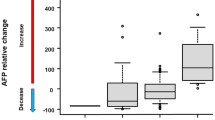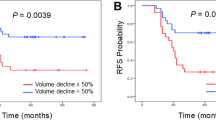Abstract
Background
Neoadjuvant chemotherapy is given to children with unresectable hepatoblastoma to increase the rate and safety of curative complete surgical resection. Elevated levels of serum alpha-fetoprotein (sAFP) decline with tumor shrinkage. In this single-institution retrospective study, we determined early dynamic changes of sAFP levels and tumor volume in children during therapy for unresectable hepatoblastoma.
Methods
We correlated early dynamic changes of sAFP levels and tumor volume and the sum of the longest primary tumor and measurable metastatic disease diameters as per RECIST 1.1 criteria with patient outcome.
Results
There were 34 patients, 7 of whom died of disease. Patients with ≥ 90% (≥ 1 log10) decrease in sAFP levels after two chemotherapy courses had a better event-free survival (P = 0.039) and overall survival (OS; P = 0.045) than those with < 90% decrease. During this treatment interval, average tumor volume decreased from 481 mL (± 254 mL) to 268 mL (± 258 mL; P < 0.001) which was associated with OS (P = 0.029). Relative change in sAFP levels or tumor volume in between course 2 and pre-surgery or response as per RECIST 1.1 was not associated with OS.
Conclusion
Early decline of sAFP levels and tumor volume, but not response as per RECIST 1.1 may predict survival in children with unresectable hepatoblastoma. This finding could be useful to identify therapy non-responders for whom alternative interventions may be required for cure. Confirmation of the finding using larger patient cohorts will be necessary before this strategy is incorporated into prospective trials.





Similar content being viewed by others
References
Perilongo G, Maibach R, Shafford E et al (2009) Cisplatin versus cisplatin plus doxorubicin for standard-risk hepatoblastoma. N Engl J Med 361:1662–1670. https://doi.org/10.1056/NEJMoa0810613
von Schweinitz D (2000) Identification of risk groups in hepatoblastoma—another step in optimising therapy. Eur J Cancer Oxf Engl 1990 36:1343–1346
Czauderna P, Otte JB, Aronson DC et al (2005) Guidelines for surgical treatment of hepatoblastoma in the modern era—recommendations from the Childhood Liver Tumour Strategy Group of the International Society of Paediatric Oncology (SIOPEL). Eur J Cancer Oxf Engl 1990 41:1031–1036. https://doi.org/10.1016/j.ejca.2005.02.004
Meyers RL, Maibach R, Hiyama E et al (2017) Risk-stratified staging in paediatric hepatoblastoma: a unified analysis from the Children’s Hepatic tumors International Collaboration. Lancet Oncol 18:122–131. https://doi.org/10.1016/S1470-2045(16)30598-8
De Ioris M, Brugieres L, Zimmermann A et al (2008) Hepatoblastoma with a low serum alpha-fetoprotein level at diagnosis: the SIOPEL group experience. Eur J Cancer Oxf Engl 1990 44:545–550. https://doi.org/10.1016/j.ejca.2007.11.022
Van Tornout JM, Buckley JD, Quinn JJ et al (1997) Timing and magnitude of decline in alpha-fetoprotein levels in treated children with unresectable or metastatic hepatoblastoma are predictors of outcome: a report from the Children’s Cancer Group. J Clin Oncol Off J Am Soc Clin Oncol 15:1190–1197
Lovvorn HN, Ayers D, Zhao Z et al (2010) Defining hepatoblastoma responsiveness to induction therapy as measured by tumor volume and serum alpha-fetoprotein kinetics. J Pediatr Surg 45:121–128. https://doi.org/10.1016/j.jpedsurg.2009.10.023 (discussion 129)
Koh KN, Park M, Kim BE et al (2011) Prognostic implications of serum alpha-fetoprotein response during treatment of hepatoblastoma. Pediatr Blood Cancer 57:554–560. https://doi.org/10.1002/pbc.23069
Zsiros J, Maibach R, Shafford E et al (2010) Successful treatment of childhood high-risk hepatoblastoma with dose-intensive multiagent chemotherapy and surgery: final results of the SIOPEL-3HR study. J Clin Oncol 28:2584–2590. https://doi.org/10.1200/JCO.2009.22.4857
Zsiros J, Brugieres L, Brock P et al (2013) Dose-dense cisplatin-based chemotherapy and surgery for children with high-risk hepatoblastoma (SIOPEL-4): a prospective, single-arm, feasibility study. Lancet Oncol 14:834–842. https://doi.org/10.1016/S1470-2045(13)70272-9
Katzenstein HM, Furman WL, Malogolowkin MH et al (2017) Upfront window vincristine/irinotecan treatment of high-risk hepatoblastoma: a report from the Children’s Oncology Group AHEP0731 study committee: vincristine/irinotecan in hepatoblastoma. Cancer 123:2360–2367. https://doi.org/10.1002/cncr.30591
Malogolowkin MH, Katzenstein H, Krailo MD et al (2006) Intensified platinum therapy is an ineffective strategy for improving outcome in pediatric patients with advanced hepatoblastoma. J Clin Oncol Off J Am Soc Clin Oncol 24:2879–2884. https://doi.org/10.1200/JCO.2005.02.6013
Amin MB, Edge S, Greene F, Byrd DR, Brookland RK, Washington MK, Gershenwald JE, Compton CC, Hess KR, Sullivan DC, Jessup JM, Brierley JD, Gaspar LE, Schilsky RL, Balch CM, Winchester DP, Asare EA, Madera M, Gress DM, Meyer LR (2017) AJCC Cancer Staging Manual. Springer, Chicago
Naus AJ, Borst A, Kuppens PS (1982) Determination of n-dimensional reference ellipsoids using patient data. J Clin Chem Clin Biochem Z Für Klin Chem Klin Biochem 20:75–80
Eisenhauer EA, Therasse P, Bogaerts J et al (2009) New response evaluation criteria in solid tumours: revised RECIST guideline (version 1.1). Eur J Cancer 45:228–247. https://doi.org/10.1016/j.ejca.2008.10.026
(2011) Base Sas 9.3 procedures guide. Sas Institute, Cary
Katzenstein HM, London WB, Douglass EC et al (2002) Treatment of unresectable and metastatic hepatoblastoma: a pediatric oncology group phase II study. J Clin Oncol Off J Am Soc Clin Oncol 20:3438–3444
Douglass EC, Reynolds M, Finegold M et al (1993) Cisplatin, vincristine, and fluorouracil therapy for hepatoblastoma: a Pediatric Oncology Group study. J Clin Oncol Off J Am Soc Clin Oncol 11:96–99
Ortega JA, Douglass EC, Feusner JH et al (2000) Randomized comparison of cisplatin/vincristine/fluorouracil and cisplatin/continuous infusion doxorubicin for treatment of pediatric hepatoblastoma: a report from the Children’s Cancer Group and the Pediatric Oncology Group. J Clin Oncol Off J Am Soc Clin Oncol 18:2665–2675
Katzenstein HM, Chang KW, Krailo M et al (2009) Amifostine does not prevent platinum-induced hearing loss associated with the treatment of children with hepatoblastoma: a report of the Intergroup Hepatoblastoma Study P9645 as a part of the Children’s Oncology Group. Cancer 115:5828–5835. https://doi.org/10.1002/cncr.24667
Casanova M, Massimino M, Ferrari A et al (2005) Etoposide, cisplatin, epirubicin chemotherapy in the treatment of pediatric liver tumors. Pediatr Hematol Oncol 22:189–198. https://doi.org/10.1080/08880010590921441
Blohm ME, Vesterling-Hörner D, Calaminus G et al (1998) Alpha 1-fetoprotein (AFP) reference values in infants up to 2 years of age. Pediatr Hematol Oncol 15:135–142
Evans AE, Land VJ, Newton WA, et al (1982) Combination chemotherapy (vincristine, adriamycin, cyclophosphamide, and 5-fluorouracil) in the treatment of children with malignant hepatoma. Cancer 50:821–826. https://doi.org/10.1002/1097-0142(19820901)50:5<821::AID-CNCR2820500502>3.0.CO;2-K
von Schweinitz D, Byrd DJ, Hecker H et al (1997) Efficiency and toxicity of ifosfamide, cisplatin and doxorubicin in the treatment of childhood hepatoblastoma. Study Committee of the Cooperative Paediatric Liver Tumour Study HB89 of the German Society for Paediatric Oncology and Haematology. Eur J Cancer Oxf Engl 1990 33:1243–1249
Brown J, Perilongo G, Shafford E et al (2000) Pretreatment prognostic factors for children with hepatoblastoma—results from the International Society of Paediatric Oncology (SIOP) study SIOPEL 1. Eur J Cancer Oxf Engl 1990 36:1418–1425
Pritchard J, Brown J, Shafford E et al (2000) Cisplatin, doxorubicin, and delayed surgery for childhood hepatoblastoma: a successful approach—results of the first prospective study of the International Society of Pediatric Oncology. J Clin Oncol Off J Am Soc Clin Oncol 18:3819–3828
Murphy AJ, Ayers GD, Hilmes MA et al (2013) Imaging analysis of hepatoblastoma resectability across neoadjuvant chemotherapy. J Pediatr Surg 48:1239–1248. https://doi.org/10.1016/j.jpedsurg.2013.03.019
Medary I, Aronson D, Cheung NK et al (1996) Kinetics of primary tumor regression with chemotherapy: implications for the timing of surgery. Ann Surg Oncol 3:521–525
Muraoka A, Tokiwa T, Sato J (1989) Effects of chemotherapeutic agents on alpha-fetoprotein secretion and growth of human hepatoma cell lines in vitro. Br J Cancer 59:569–572
Venkatramani R, Wang L, Malvar J et al (2012) Tumor necrosis predicts survival following neo-adjuvant chemotherapy for hepatoblastoma. Pediatr Blood Cancer 59:493–498. https://doi.org/10.1002/pbc.24038
Otte JB, Pritchard J, Aronson DC et al (2004) Liver transplantation for hepatoblastoma: results from the International Society of Pediatric Oncology (SIOP) study SIOPEL-1 and review of the world experience. Pediatr Blood Cancer 42:74–83. https://doi.org/10.1002/pbc.10376
Howlander N, Noone A, Krapcho M et al (2011) SEER cancer statistics review, 1975–2009. National Cancer Institute, Bethesda
Acknowledgements
Special thanks to Vani Shanker for editing the manuscript.
Author information
Authors and Affiliations
Corresponding author
Ethics declarations
Conflict of interest
The authors have no conflict of interest.
About this article
Cite this article
Nguyen, R., McCarville, M.B., Sykes, A. et al. Rapid decrease of serum alpha-fetoprotein and tumor volume predicts outcome in children with hepatoblastoma treated with neoadjuvant chemotherapy. Int J Clin Oncol 23, 900–907 (2018). https://doi.org/10.1007/s10147-018-1285-4
Received:
Accepted:
Published:
Issue Date:
DOI: https://doi.org/10.1007/s10147-018-1285-4




